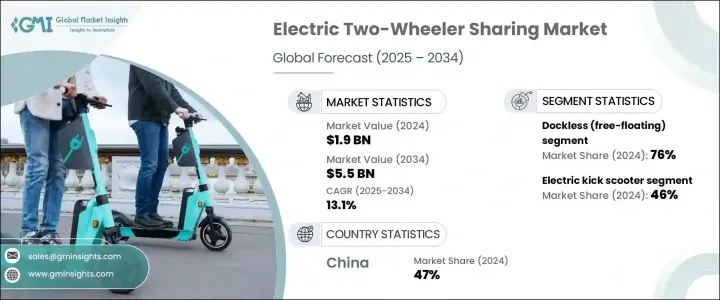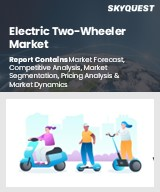
|
시장보고서
상품코드
1740962
전기 이륜차 공유 시장 : 시장 기회, 성장 촉진요인, 산업 동향 분석 및 예측(2025-2034년)Electric Two-Wheeler Sharing Market Opportunity, Growth Drivers, Industry Trend Analysis, and Forecast 2025 - 2034 |
||||||
세계의 전기 이륜차 공유 시장 규모는 2024년에 19억 달러로 평가되었고, 2034년에는 55억 달러에 이를 것으로 예측되며, CAGR 13.1%로 성장할 전망입니다.
도시 인구가 계속 증가하고 주요 도시가 교통 혼잡 문제에 직면함에 따라 전통적인 대중교통과 개인 차량으로는 단거리 및 라스트 마일 연결성을 해결하기에는 역부족인 경우가 많습니다. 이러한 상황에서 전기 이륜차 공유 서비스가 등장했습니다. 이러한 솔루션은 빠르고 유연하며 친환경적인 대안으로, 특히 인구 밀집 지역에서 일상적인 출퇴근에 원활하게 맞출 수 있습니다. 이제 소비자들은 차량 소유에 따른 책임감보다 편의성, 이동성, 비용 효율성을 우선시합니다. 사용자 친화적인 앱을 통해 제공되는 공유 전기 모빌리티 서비스를 통해 라이더는 교통 혼잡이나 공해를 유발하지 않으면서도 일상적인 교통 수요를 충족하는 전기차를 실시간으로 이용할 수 있습니다. 도시 교통 행태의 변화는 기술에 정통한 젊은 층이 서비스형 모빌리티(MaaS) 플랫폼을 선호하면서 새로운 차원으로 이동수단 채택을 촉진하는 데에도 영향을 미치고 있습니다.

환경에 대한 인식이 높아지고 전 세계적으로 친환경 모빌리티에 대한 관심이 높아지는 것도 이 시장의 주요 성장 동력이 되고 있습니다. 탄소 배출, 대기 질 악화, 도시 교통 체증이 심화되면서 전기 모빌리티가 논리적이고 지속 가능한 해결책으로 떠오르고 있습니다. 공유 전기차는 배기가스를 전혀 배출하지 않으며 기존의 가스 동력 차량에 비해 유지보수 비용이 현저히 낮습니다. 이러한 장점은 탄소 발자국을 줄이려는 소비자와 지속 가능성 목표를 달성하려는 도시 공무원 모두에게 매력적입니다. 보조금과 세금 혜택부터 무공해 구역과 전기자동차 충전 인프라 구축에 이르기까지 정부의 지원도 중요한 역할을 하고 있습니다. 이러한 노력은 스마트한 친환경 도시로의 광범위한 변화에 발맞춰 채택을 촉진하고 있습니다.
| 시장 범위 | |
|---|---|
| 시작 연도 | 2024년 |
| 예측 연도 | 2025-2034년 |
| 시작 금액 | 19억 달러 |
| 예측 금액 | 55억 달러 |
| CAGR | 13.1% |
2024년에는 전기 킥보드가 46%의 점유율로 시장을 주도했으며, 2034년까지 12.5%의 연평균 성장률로 성장할 것으로 예상됩니다. 전기 킥보드의 컴팩트한 크기, 사용 편의성, 경제성 덕분에 도시 라이더들이 선호하는 옵션입니다. 특히 기존 차량이 어려움을 겪는 좁은 도심 공간에서 유용하며, 유지비가 저렴하기 때문에 빠르게 확장하려는 모빌리티 제공업체에게 매력적인 선택입니다.
도크리스 또는 프리 플로팅 시스템은 2024년 76%의 점유율로 시장을 장악했으며 2034년까지 13%의 연평균 성장률로 강력한 모멘텀을 유지할 것으로 예상됩니다. 이러한 시스템을 통해 사용자는 승인된 지역 내 어디에서나 차량을 픽업하고 하차할 수 있어 최고의 편의성을 제공합니다. 앱 기반 플랫폼은 원활한 예약, 추적 및 결제를 가능하게 하며, 도시에서는 교통 혼잡을 줄이고 청정 모빌리티 목표를 발전시키는 역할을 하는 이러한 시스템을 지원합니다.
중국의 전기 이륜차 공유 시장은 급속한 도시화, 정부 주도의 전기차 정책, 강력한 전기차 인프라 덕분에 2024년에 3억 1850만 달러에 달할 것으로 예상됩니다. 배터리 교환 스테이션, 스마트 충전 네트워크, 모바일 통합 서비스 덕분에 공유 전기 모빌리티는 효율적이고 폭넓게 이용할 수 있게 되었습니다.
Bird.co, TIER Mobility, Yulu, Bolt, GrabWheels, Voi Technology, Revel, Dott, Lime Micromobility, Helbiz 등의 대기업은 차량을 확대하고, 루트와 배터리의 효율을 높이고, 도시 정부와 제휴하고 있습니다. 많은 기업이 사용자 경험을 개선하고 비용을 절감하기 위해 AI 기반 차량 관리, 동적 가격 책정, 대중교통 통합에 투자하고 있습니다. 환경을 고려한 운영과 순환 경제 관행도 자리를 잡아가고 있으며, 이를 통해 기업은 규정을 준수하고 친환경적인 사용자들에게 어필할 수 있습니다.
목차
제1장 조사 방법과 범위
제2장 주요 요약
제3장 업계 인사이트
- 생태계 분석
- 공급자의 상황
- 전기 이륜차 제조업체
- 배터리 및 충전 인프라 제공업체
- 기술 및 소프트웨어 플랫폼 개발자
- 공유 모빌리티 사업자
- 시 당국과 규제 기관
- 이익률 분석
- 트럼프 정권에 의한 관세에 대한 영향
- 무역에 미치는 영향
- 무역량의 혼란
- 타국에 의한 보복조치
- 업계에 미치는 영향
- 주요 원자재의 가격 변동
- 공급망 재구성
- 생산 비용에 미치는 영향
- 영향을 받는 주요 기업
- 전략적인 업계 대응
- 공급망 재구성
- 가격 설정 및 제품 전략
- 전망과 향후 검토 사항
- 무역에 미치는 영향
- 기술과 혁신의 상황
- 코스트 내역 분석
- 가격 동향
- 특허 분석
- 주요 뉴스와 대처
- 규제 상황
- 영향요인
- 성장 촉진요인
- 도시 혼잡과 라스트 마일 수요 증가
- 환경 문제 및 지속 가능성에 대한 관심 증가
- 비용 효율적인 모빌리티 옵션
- 전기자동차 보조금, 우호적인 규제 및 인프라 투자
- 기술 발전 및 앱 통합
- 업계의 잠재적 위험 및 과제
- 높은 초기 투자 비용
- 제한된 충전 인프라
- 성장 촉진요인
- 성장 가능성 분석
- Porter's Five Forces 분석
- PESTEL 분석
제4장 경쟁 구도
- 소개
- 기업의 시장 점유율 분석
- 경쟁 포지셔닝 매트릭스
- 전략적 전망 매트릭스
제5장 시장 추계 및 예측 : 차량별(2021-2034년)
- 주요 동향
- 전기 오토바이
- 전기 스쿠터
- 전기 자전거
- 전기 킥보드
제6장 시장 추계 및 예측 : 공유 시스템(2021-2034년)
- 주요 동향
- 도킹
- 도크리스(프리 플로팅)
제7장 시장 추계 및 예측 : 배터리별(2021-2034년)
- 주요 동향
- 분리 가능/교환 가능한 배터리
- 고정/일체형 배터리
제8장 시장 추계 및 예측 : 최종 용도별(2021-2034년)
- 주요 동향
- 개인 소비자
- 관광객
- 기업 및 기관 사용자
제9장 시장 추계 및 예측 : 비즈니스 모델별(2021-2034년)
- 주요 동향
- B2C(기업 대 소비자)
- B2B(기업간)
- P2P(개인간)
제10장 시장 추계 및 예측 : 지역별(2021-2034년)
- 주요 동향
- 북미
- 미국
- 캐나다
- 유럽
- 영국
- 독일
- 프랑스
- 이탈리아
- 스페인
- 러시아
- 북유럽 국가
- 아시아태평양
- 중국
- 인도
- 일본
- 한국
- 호주 및 뉴질랜드
- 동남아시아
- 라틴아메리카
- 브라질
- 멕시코
- 아르헨티나
- 중동 및 아프리카
- 아랍에미리트(UAE)
- 사우디아라비아
- 남아프리카
제11장 기업 프로파일
- Bird.co
- Bolt
- Bounce Infinity
- Cityscoot
- Cooltra
- Dott
- emmy Sharing
- Felyx
- GoShare(by Gogoro)
- GrabWheels
- Grin
- Helbiz
- HelloBike
- Lime Micromobility
- Meituan(Mobike)
- Revel
- Spin
- TIER Mobility
- Voi Technology
- Yulu
The Global Electric Two-Wheeler Sharing Market was valued at USD 1.9 billion in 2024 and is estimated to grow at a CAGR of 13.1% to reach USD 5.5 billion by 2034. As urban populations continue to rise and major cities face mounting congestion issues, traditional public transport, and personal vehicles often fall short when it comes to addressing short-distance and last-mile connectivity. That's where electric two-wheeler sharing services come in. These solutions offer a fast, flexible, and eco-friendly alternative that fits seamlessly into daily commutes, particularly in densely populated areas. Consumers now prioritize convenience, mobility, and cost-efficiency over the responsibilities of vehicle ownership. With shared e-mobility services available through user-friendly apps, riders enjoy real-time access to electric vehicles that meet their daily transport needs without contributing to traffic congestion or pollution. The shift in urban transport behavior is also being shaped by the younger, tech-savvy demographic that prefers mobility-as-a-service (MaaS) platforms, pushing adoption to new heights.

Rising environmental awareness and a global push for clean mobility have become major growth drivers for this market. As carbon emissions, poor air quality, and urban traffic jams escalate, electric mobility emerges as a logical and sustainable solution. Shared electric vehicles produce zero tailpipe emissions and come with significantly lower maintenance demands compared to traditional gas-powered alternatives. These benefits appeal to both consumers looking to reduce their carbon footprint and city officials working toward sustainability targets. Government support is playing a crucial role as well-ranging from subsidies and tax incentives to the rollout of zero-emission zones and electric vehicle charging infrastructure. These initiatives are boosting adoption while also aligning with the broader shift toward smart, green cities.
| Market Scope | |
|---|---|
| Start Year | 2024 |
| Forecast Year | 2025-2034 |
| Start Value | $1.9 Billion |
| Forecast Value | $5.5 Billion |
| CAGR | 13.1% |
In 2024, electric kick scooters led the market, holding a 46% share, and are projected to grow at a CAGR of 12.5% through 2034. Their compact size, ease of use, and affordability make them a go-to option for urban riders. They're especially useful in tight urban spaces where traditional vehicles struggle, and their low maintenance costs make them an attractive choice for mobility providers looking to scale quickly.
Dockless, or free-floating, systems dominated the market with a 76% share in 2024 and are expected to maintain strong momentum, growing at a 13% CAGR through 2034. These systems let users pick up and drop off vehicles anywhere within approved areas, offering unmatched convenience. App-based platforms enable seamless booking, tracking, and payment, while cities support these systems for their role in reducing congestion and advancing clean mobility goals.
China's Electric Two-Wheeler Sharing Market reached USD 318.5 million in 2024, thanks to rapid urbanization, government-led EV policies, and strong EV infrastructure. Battery-swapping stations, smart charging networks, and mobile-integrated services have made shared e-mobility efficient and widely accessible.
Leading players like Bird.co, TIER Mobility, Yulu, Bolt, GrabWheels, Voi Technology, Revel, Dott, Lime Micromobility, and Helbiz are expanding fleets, enhancing route and battery efficiency, and partnering with city governments. Many are investing in AI-powered fleet management, dynamic pricing, and public transit integration to improve user experience and cut costs. Eco-conscious operations and circular economy practices are also gaining ground, helping companies comply with regulations and appeal to green-minded users.
Table of Contents
Chapter 1 Methodology & Scope
- 1.1 Research design
- 1.1.1 Research approach
- 1.1.2 Data collection methods
- 1.2 Base estimates and calculations
- 1.2.1 Base year calculation
- 1.2.2 Key trends for market estimates
- 1.3 Forecast model
- 1.4 Primary research & validation
- 1.4.1 Primary sources
- 1.4.2 Data mining sources
- 1.5 Market definitions
Chapter 2 Executive Summary
- 2.1 Industry 3600 synopsis, 2021 - 2034
Chapter 3 Industry Insights
- 3.1 Industry ecosystem analysis
- 3.2 Supplier landscape
- 3.2.1 Electric two-wheeler manufacturers
- 3.2.2 Battery and charging infrastructure providers
- 3.2.3 Technology and software platform developers
- 3.2.4 Shared mobility operators
- 3.2.5 City authorities and regulatory bodies
- 3.3 Profit margin analysis
- 3.4 Trump administration tariffs
- 3.4.1 Impact on trade
- 3.4.1.1 Trade volume disruptions
- 3.4.1.2 Retaliatory measures by other countries
- 3.4.2 Impact on the industry
- 3.4.2.1 Price volatility in key materials
- 3.4.2.2 Supply chain restructuring
- 3.4.2.3 Production cost implications
- 3.4.3 Key companies impacted
- 3.4.4 Strategic industry responses
- 3.4.4.1 Supply chain reconfiguration
- 3.4.4.2 Pricing and product strategies
- 3.4.5 Outlook and future considerations
- 3.4.1 Impact on trade
- 3.5 Technology & innovation landscape
- 3.6 Cost breakdown analysis
- 3.7 Price trends
- 3.8 Patent analysis
- 3.9 Key news & initiatives
- 3.10 Regulatory landscape
- 3.11 Impact forces
- 3.11.1 Growth drivers
- 3.11.1.1 Rising urban congestion and last-mile needs
- 3.11.1.2 Growing environmental concerns and sustainability focus
- 3.11.1.3 Cost-effective mobility option
- 3.11.1.4 Subsidies on electric vehicles, favorable regulations, and infrastructure investments
- 3.11.1.5 Technological advancements and app integration
- 3.11.2 Industry pitfalls & challenges
- 3.11.2.1 High initial investment
- 3.11.2.2 Limited charging infrastructure
- 3.11.1 Growth drivers
- 3.12 Growth potential analysis
- 3.13 Porter's analysis
- 3.14 PESTEL analysis
Chapter 4 Competitive Landscape, 2024
- 4.1 Introduction
- 4.2 Company market share analysis
- 4.3 Competitive positioning matrix
- 4.4 Strategic outlook matrix
Chapter 5 Market Estimates & Forecast, By Vehicle, 2021 - 2034 ($Bn, Fleet Size)
- 5.1 Key trends
- 5.2 Electric motorcycle
- 5.3 Electric scooter
- 5.4 E-bikes
- 5.5 Electric kick scooter
Chapter 6 Market Estimates & Forecast, By Sharing System, 2021 - 2034 ($Bn, Fleet Size)
- 6.1 Key trends
- 6.2 Docked
- 6.3 Dockless (Free-Floating)
Chapter 7 Market Estimates & Forecast, By Battery, 2021 - 2034 ($Bn, Fleet Size)
- 7.1 Key trends
- 7.2 Removable/swappable battery
- 7.3 Fixed/integrated battery
Chapter 8 Market Estimates & Forecast, By End Use, 2021 - 2034 ($Bn, Fleet Size)
- 8.1 Key trends
- 8.2 Individual consumers
- 8.3 Tourists
- 8.4 Corporate/institutional users
Chapter 9 Market Estimates & Forecast, By Business Model, 2021 - 2034 ($Bn, Fleet Size)
- 9.1 Key trends
- 9.2 B2C (Business-to-Consumer)
- 9.3 B2B (Business-to-Business)
- 9.4 P2P (Peer-to-Peer) sharing
Chapter 10 Market Estimates & Forecast, By Region, 2021 - 2034 ($Bn, Fleet Size)
- 10.1 Key trends
- 10.2 North America
- 10.2.1 U.S.
- 10.2.2 Canada
- 10.3 Europe
- 10.3.1 UK
- 10.3.2 Germany
- 10.3.3 France
- 10.3.4 Italy
- 10.3.5 Spain
- 10.3.6 Russia
- 10.3.7 Nordics
- 10.4 Asia Pacific
- 10.4.1 China
- 10.4.2 India
- 10.4.3 Japan
- 10.4.4 South Korea
- 10.4.5 ANZ
- 10.4.6 Southeast Asia
- 10.5 Latin America
- 10.5.1 Brazil
- 10.5.2 Mexico
- 10.5.3 Argentina
- 10.6 MEA
- 10.6.1 UAE
- 10.6.2 Saudi Arabia
- 10.6.3 South Africa
Chapter 11 Company Profiles
- 11.1 Bird.co
- 11.2 Bolt
- 11.3 Bounce Infinity
- 11.4 Cityscoot
- 11.5 Cooltra
- 11.6 Dott
- 11.7 emmy Sharing
- 11.8 Felyx
- 11.9 GoShare (by Gogoro)
- 11.10 GrabWheels
- 11.11 Grin
- 11.12 Helbiz
- 11.13 HelloBike
- 11.14 Lime Micromobility
- 11.15 Meituan (Mobike)
- 11.16 Revel
- 11.17 Spin
- 11.18 TIER Mobility
- 11.19 Voi Technology
- 11.20 Yulu



















